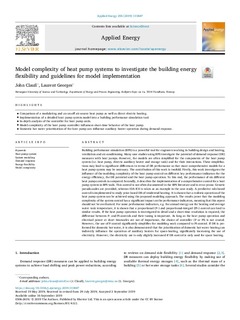| dc.contributor.author | Clauß, John | |
| dc.contributor.author | Georges, Laurent | |
| dc.date.accessioned | 2019-11-19T08:41:21Z | |
| dc.date.available | 2019-11-19T08:41:21Z | |
| dc.date.created | 2019-11-18T13:36:13Z | |
| dc.date.issued | 2019 | |
| dc.identifier.issn | 0306-2619 | |
| dc.identifier.uri | http://hdl.handle.net/11250/2629177 | |
| dc.description.abstract | Building performance simulation (BPS) is a powerful tool for engineers working in building design and heating, ventilation and air-conditioning. Many case studies using BPS investigate the potential of demand response (DR) measures with heat pumps. However, the models are often simplified for the components of the heat pump system (i.e. heat pump, electric auxiliary heater and storage tank) and for their interactions. These simplifications may lead to significant differences in terms of DR performance so that more comprehensive models for a heat pump system may be necessary. The contribution of this work is twofold. Firstly, this work investigates the influence of the modeling complexity of the heat pump control on different key performance indicators for the energy efficiency, the DR potential and the heat pump operation. To this end, the performance of six different heat pump controls is compared. Secondly, it describes the implementation of a comprehensive control for a heat pump system in BPS tools. This control is not often documented in the BPS literature and is error-prone. Generic pseudo-codes are provided, whereas IDA ICE is taken as an example in the case study. A predictive rule-based control is implemented to study price-based DR of residential heating. It is shown that a realistic operation of the heat pump system can be achieved using the proposed modeling approach. The results prove that the modeling complexity of the system control has a significant impact on the performance indicators, meaning that this aspect should not be overlooked. For some performance indicators, e.g. the annual energy use for heating and average water tank temperature, it is shown that a proportional (P-) and proportional-integral (PI-) control can lead to similar results. If the heat pump operation is investigated in detail and a short-time resolution is required, the difference between P- and PI-controls and their tuning is important. As long as the heat pump operation and electrical power at short timescales are not of importance, the choice of controller (P or PI) is not crucial. However, the use of P-control significantly simplifies the modeling work compared to PI-control. If DR is performed for domestic hot water, it is also demonstrated that the prioritization of domestic hot water heating can indirectly influence the operation of auxiliary heaters for space-heating, significantly increasing the use of electricity. However, the electricity use is only slightly increased if DR control is only used for space heating. | nb_NO |
| dc.description.abstract | Model complexity of heat pump systems to investigate the building energy flexibility and guidelines for model implementation | nb_NO |
| dc.language.iso | eng | nb_NO |
| dc.publisher | Elsevier | nb_NO |
| dc.relation.uri | https://www.sciencedirect.com/science/article/pii/S030626191931534X | |
| dc.rights | Navngivelse 4.0 Internasjonal | * |
| dc.rights.uri | http://creativecommons.org/licenses/by/4.0/deed.no | * |
| dc.title | Model complexity of heat pump systems to investigate the building energy flexibility and guidelines for model implementation | nb_NO |
| dc.type | Journal article | nb_NO |
| dc.type | Peer reviewed | nb_NO |
| dc.description.version | publishedVersion | nb_NO |
| dc.source.volume | 255 | nb_NO |
| dc.source.journal | Applied Energy | nb_NO |
| dc.identifier.doi | 10.1016/j.apenergy.2019.113847 | |
| dc.identifier.cristin | 1748853 | |
| dc.relation.project | Norges forskningsråd: 257660 | nb_NO |
| dc.description.localcode | © 2019 The Authors. Published by Elsevier Ltd. This is an open access article under the CC BY license (http://creativecommons.org/licenses/BY/4.0/). | nb_NO |
| cristin.unitcode | 194,64,25,0 | |
| cristin.unitname | Institutt for energi- og prosessteknikk | |
| cristin.ispublished | true | |
| cristin.fulltext | original | |
| cristin.qualitycode | 1 | |

